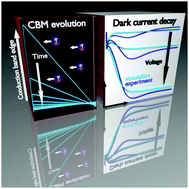Abstract
The current decay in response to a sudden change of applied bias up to 1 V has been measured on a methylammonium lead triiodide perovskite solar cell with titania and spiro-OMeTAD transport layers, for temperatures between 258 and 308 K. These measurements are highly reproducible, in contrast to most other techniques used to investigate perovskite cells. A drift–diffusion model that accounts for slow moving ions as well as electrons and holes acting as charge carriers was used to predict the current transients. The close fit of the model predictions to the measurements shows that mobile ions in the perovskite layer influence transient behaviour on timescales of up to 50 s. An activation energy of 0.55 eV is inferred from fitting simulations to measurements made at room temperature.



 Please wait while we load your content...
Please wait while we load your content...